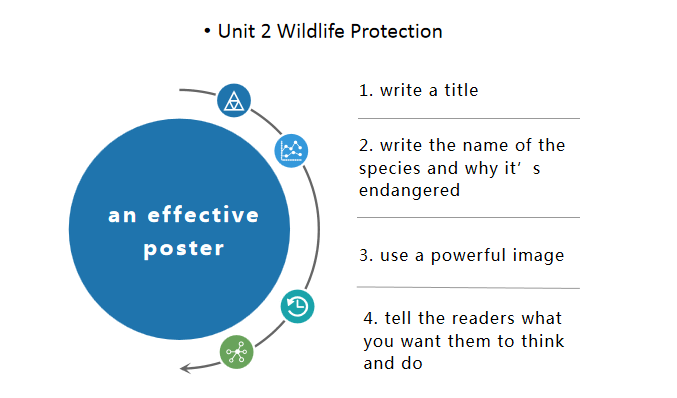一、教学目标
1. Students can learn the features of an effective poster through the reading materials;
2. Students can organize a poster by themselves to deliver some information;
3. Students can improve their abilities of getting information and writing through this lesson;
4. Students can cultivate their awareness of protecting wildlife.
二、教学重难点
Teaching key point:
Students are able to organize a poster by themselves to deliver some information.
Teaching difficult points:
Students can improve their skills in writing and can cultivate their awareness of protecting wildlife.
三、教学过程
Step 1. Lead-in
At the beginning of the class, the teacher plays a video of endangered animals and asks them whether they know the condition of the wildlife. Then guide students to begin the new lesson.
Step 2. Pre-writing
Lead students to read the passage first and answer the following questions:
What dose each poster use to stir up emotions?
What dose each poster want people to do? How do you know?
In your opinion, which poster is more effective and why?
What’s the format of a poster?
Step 3. While-writing
Work in pairs to make a poster about an endangered animal:
First, choose one animal between South China Tiger and Yangtze River Dolphin. Then, follow these steps to organize a poster: write a title; write the name of the species and why it’s endangered; use a powerful image to attract attention; tell the readers what they are wanted to think and do.
Step 4. Post- writing
1. Students exchange posters with another pair and use the checklist in the textbook to check their writings.
2. Students modify their own writings.
3. Select the best ones.
Step 5. Summary
Students summarize what they have learned today and the teacher gives proper supplements. Then, the teacher reminds students to protect the wildlife and develop positive system of values and attitudes. In addition, the teacher also tells students that they can use posters to deliver information in their daily life.
Step 6. Homework
1. Guide students to put up these posters in their school;
2. Encourage students to search for more information about wildlife protection and share it next class.
四、板书设计












